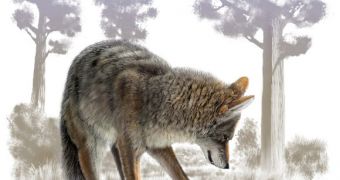Researchers in the United States have recently determined that gray wolves and coyotes took the last Ice Age pretty rough, but managed to survive. The study indicates that the two were once similar in appearance, and suggests that each of the species may have taken a different evolutionary path.
The next question that needs to be answered in that scenario is what are the factors that forced the two species to evolve so differently. Their appearance is not very similar today, and 10,000 years is a rather brief period of time for such important changes to appear.
The last Ice Age brought about the disappearance of numerous large species of mammals, and forced countless others to experience changes in body size. Wolves and coyotes were no exception, but their paths have been in constant divergence since then.
What experts are especially interested in are the reasons why that happened. The new investigation was carried out by expert Jule Meachen, who is based at the US National Science Foundation (NSF) National Evolutionary Synthesis Center.
She worked closely with colleague Josh Samuels, who holds an appointment with the Hohn Day Fossil Beds National Monument. Details of the investigation appear in the latest issue of the esteemed journal Proceedings of the National Academy of Sciences (PNAS).
One of the most significant differences between the two species is that coyotes became smaller and less likely to hunt in large packs. Wolves were largely left unchanged, the team adds. One reason for this could be that the large predators and prey that coyotes needed to face mostly disappeared.
On average, modern coyotes are about 2 feet (60 centimeters) shorter from nose to tail than wolves. They are also less than half the weight. A coyote weighs an average of 30 to 40 pounds (14 to 18 kilograms), whereas a wolf is between 80 and 120 pounds (36 to 54 kilograms).
In order to understand why these differences occurred, Meachen and Samuels analyzed the influence of Bergmann's Rule on the two species. This is an ecogeographic principle which holds that animals tend to get bigger the farther they live (or move) from the Equator, and the colder the climate they're in is.
But this correlation between climate and body size is not present in the coyote. One explanation was found by analyzing fossilized specimens from both before and after the Ice Age. It was found that the older coyotes were more carnivorous than their more modern counterparts.
“In a time of increasing loss of biodiversity, understanding the degree to which species interactions drive evolutionary change is important,” explains Saran Twombly, a NSF Division of Environmental Biology program director.

 14 DAY TRIAL //
14 DAY TRIAL //